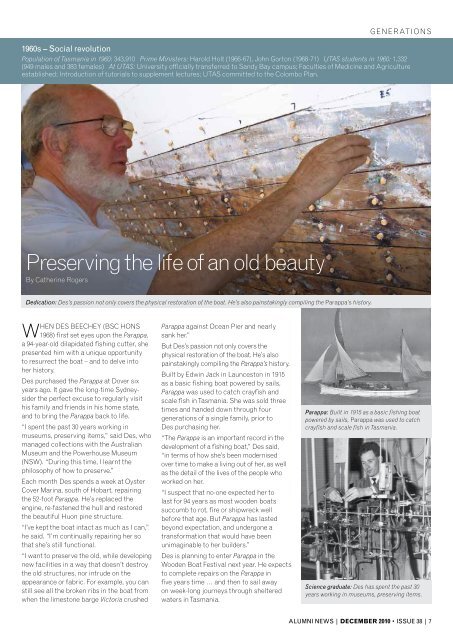GENERATIONS AT UTAS - Alumni & Friends - University of Tasmania
GENERATIONS AT UTAS - Alumni & Friends - University of Tasmania
GENERATIONS AT UTAS - Alumni & Friends - University of Tasmania
Create successful ePaper yourself
Turn your PDF publications into a flip-book with our unique Google optimized e-Paper software.
WheN DeS BeeCheY (BSC hoNS<br />
1968) first set eyes upon the Parappa,<br />
a 94-year-old dilapidated fishing cutter, she<br />
presented him with a unique opportunity<br />
to resurrect the boat – and to delve into<br />
her history.<br />
Des purchased the Parappa at Dover six<br />
years ago. It gave the long-time Sydneysider<br />
the perfect excuse to regularly visit<br />
his family and friends in his home state,<br />
and to bring the Parappa back to life.<br />
“I spent the past 30 years working in<br />
museums, preserving items,” said Des, who<br />
managed collections with the Australian<br />
Museum and the Powerhouse Museum<br />
(NSW). “During this time, I learnt the<br />
philosophy <strong>of</strong> how to preserve.”<br />
each month Des spends a week at oyster<br />
Cover Marina, south <strong>of</strong> hobart, repairing<br />
the 52-foot Parappa. he’s replaced the<br />
engine, re-fastened the hull and restored<br />
the beautiful huon pine structure.<br />
“I’ve kept the boat intact as much as I can,”<br />
he said. “I’m continually repairing her so<br />
that she’s still functional.<br />
“I want to preserve the old, while developing<br />
new facilities in a way that doesn’t destroy<br />
the old structures, nor intrude on the<br />
appearance or fabric. For example, you can<br />
still see all the broken ribs in the boat from<br />
when the limestone barge Victoria crushed<br />
Parappa against ocean Pier and nearly<br />
sank her.”<br />
But Des’s passion not only covers the<br />
physical restoration <strong>of</strong> the boat. he’s also<br />
painstakingly compiling the Parappa’s history.<br />
Built by edwin Jack in Launceston in 1915<br />
as a basic fishing boat powered by sails,<br />
Parappa was used to catch crayfish and<br />
scale fish in <strong>Tasmania</strong>. She was sold three<br />
times and handed down through four<br />
generations <strong>of</strong> a single family, prior to<br />
Des purchasing her.<br />
“The Parappa is an important record in the<br />
development <strong>of</strong> a fishing boat,” Des said,<br />
“in terms <strong>of</strong> how she’s been modernised<br />
over time to make a living out <strong>of</strong> her, as well<br />
as the detail <strong>of</strong> the lives <strong>of</strong> the people who<br />
worked on her.<br />
“I suspect that no-one expected her to<br />
last for 94 years as most wooden boats<br />
succumb to rot, fire or shipwreck well<br />
before that age. But Parappa has lasted<br />
beyond expectation, and undergone a<br />
transformation that would have been<br />
unimaginable to her builders.”<br />
Des is planning to enter Parappa in the<br />
Wooden Boat Festival next year. he expects<br />
to complete repairs on the Parappa in<br />
five years time … and then to sail away<br />
on week-long journeys through sheltered<br />
waters in <strong>Tasmania</strong>.<br />
GeNeR<strong>AT</strong>IoNS<br />
1960s – social revolution<br />
Population <strong>of</strong> <strong>Tasmania</strong> in 1960: 343,910 Prime Ministers: harold holt (1966-67), John Gorton (1968-71) <strong>UTAS</strong> students in 1960: 1,332<br />
(949 males and 383 females) At <strong>UTAS</strong>: <strong>University</strong> <strong>of</strong>ficially transferred to Sandy Bay campus; Faculties <strong>of</strong> Medicine and Agriculture<br />
established; Introduction <strong>of</strong> tutorials to supplement lectures; <strong>UTAS</strong> committed to the Colombo Plan.<br />
Preserving the life <strong>of</strong> an old beauty<br />
By Catherine Rogers<br />
Dedication: Des’s passion not only covers the physical restoration <strong>of</strong> the boat. He’s also painstakingly compiling the Parappa’s history.<br />
Parappa: Built in 1915 as a basic fishing boat<br />
powered by sails, Parappa was used to catch<br />
crayfish and scale fish in <strong>Tasmania</strong>.<br />
Science graduate: Des has spent the past 30<br />
years working in museums, preserving items.<br />
aLUmni neWs | DECEMBER 2010 • Issue 38 | 7


